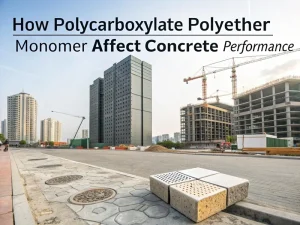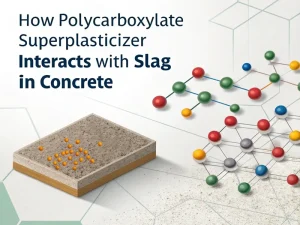Blog
As an important member of the field of concrete admixtures, polycarboxylate superplasticizer has a molecular weight difference that is like a magical key, which can open the door to different application properties and have a significant impact on the various characteristics of concrete.
The influence of polycarboxylate superplasticizer molecular weight on its application performance is mainly reflected in the following key aspects.
The molecular weight of polycarboxylate superplasticizer is usually between 10000-100000.
In the preparation process of concrete, fluidity is a crucial performance indicator.
Polycarboxylates with a lower molecular weight typically have better flowability because they interact more easily with water molecules, reducing the viscosity of the cement paste. High molecular weight polycarboxylates, on the other hand, tend to increase the viscosity of the mixture, which may result in poorer flowability.
Polycarboxylate superplasticizer with lower molecular weight have relatively small and lightweight molecular structures. This allows them to easily and efficiently interact intimately with water molecules. When they are integrated into the cement slurry, they can quickly form a relatively stable water film around the cement particles, effectively separating them from each other. This separation greatly weakens the internal friction between cement particles, thereby significantly reducing the viscosity of the cement slurry.
In practical engineering applications, this low molecular weight polycarboxylate superplasticizer endows concrete with good flowability, enabling it to be smoothly filled into various corners of complex molds without excessive external vibration, relying on its gravity, meeting the high requirements for concrete flowability in construction scenarios such as thin-walled structures and irregular components.
In sharp contrast, high molecular weight polycarboxylate superplasticizers have larger molecular volumes, longer molecular chains, and more complex entanglement with each other. When they enter the cement slurry system, they will form a thick and complex adsorption layer on the surface of cement particles. Although this adsorption layer has unique functions in certain aspects, it also increases the intermolecular interaction forces, leading to a significant increase in the viscosity of the cement slurry. Duing the construction process, the flow of concrete becomes difficult, which may result in slow flow and difficulty filling molds, leading to poor fluidity.

Polycarboxylate superplasticizer with higher molecular weight usually have strong dispersibility, which can effectively reduce the cohesiveness of cement and achieve a better water reduction effect. polycarboxylate superplasticizer with lower molecular weight may require higher amounts to achieve the same water-reduction effect.
Polycarboxylate superplasticizer with higher molecular weight can form a more solid and extensive adsorption layer on the surface of cement particles due to their larger molecular structure and abundant active groups. This adsorption layer effectively pushes cement particles away from each other through various mechanisms, such as electrostatic repulsion and steric hindrance, greatly reducing the cohesiveness of cement.
Figuratively speaking, it’s like inserting many sturdy separators between a tightly packed group of small balls, greatly reducing the attraction between the balls. Through this powerful dispersing effect, cement particles can be more evenly dispersed in the concrete system, and the water that was originally wrapped by cement particles and could not effectively participate in the work can be released, thus exerting a more outstanding water reduction effect. In practical applications, a relatively small amount of high molecular weight polycarboxylate superplasticizer is needed to significantly reduce the water-cement ratio of concrete and improve its strength, durability, and other properties.
On the other hand, polycarboxylate superplasticizers with lower molecular weight have relatively simple molecular structures and fewer active groups, resulting in weaker adsorption and dispersion abilities on the surface of cement particles. In order to achieve the same water-reducing effect as high molecular weight polycarboxylate superplasticizers, higher dosages are often required. This not only increases material costs but may also affect other properties of concrete to some extent, such as the possibility of introducing too many bubbles.
High molecular weight polycarboxylates may improve the durability of concrete, particularly in terms of impermeability and crack resistance. Because of their larger molecules, they can better stabilize the cement matrix, enhancing resistance to freeze-thaw cycles and chemical corrosion.
The durability of concrete is directly related to the service life and safety of building structures. High molecular weight polycarboxylate superplasticizers exhibit unique advantages in this regard. Due to their larger molecules, they can better participate in the formation of the cement matrix structure during concrete hardening, interweaving with cement hydration products to form a more stable and dense microstructure. This dense structure can effectively block the invasion of moisture, harmful gases, and various corrosive media, significantly improving the impermeability of concrete.
In terms of crack resistance, high molecular weight polycarboxylate superplasticizer can enhance the cohesion and toughness of cement matrix. When concrete is affected by external factors such as temperature changes, humidity changes, or mechanical stress, stress concentration occurs inside, which can easily lead to cracks. The stable structure formed by high molecular weight polycarboxylate superplasticizer can effectively disperse these stresses, just like installing many small buffering devices inside concrete, reducing the possibility of crack formation.
At the same time, when concrete is subjected to freeze-thaw cycles, this stable structure can also enhance the ability of concrete to resist frost heave damage and improve its freeze-thaw resistance. In addition, for chemical erosion environments, high molecular weight polycarboxylate superplasticizers can also, to some extent, inhibit the chemical reaction between cement and corrosive media, enhancing the resistance of concrete to chemical erosion.
Polycarboxylates with lower molecular weights can disperse cement particles quickly, but they may be more susceptible to adsorption by cement particles during long mixing times, which could lead to a reduction in effectiveness. Polycarboxylates with higher molecular weights, on the other hand, exhibit stronger and more durable dispersing ability.
In the initial stage, polycarboxylate superplasticizers with lower molecular weight can quickly diffuse around cement particles due to their relatively small molecules. Through their active functional groups, they can adsorb and disperse cement particles rapidly. In the initial stage of concrete mixing, it can make the concrete have good fluidity and workability.
However, with the extension of mixing time, cement particles will continue to adsorb low molecular weight polycarboxylate superplasticizer molecules, resulting in a gradual decrease in their concentration on the surface of cement particles and a weakening of intermolecular interactions. Therefore, during the long-term mixing process, the dispersion effect of low molecular weight polycarboxylate superplasticizer is prone to decay, and the fluidity and workability of concrete will also decrease accordingly.
In contrast, polycarboxylate superplasticizers with higher molecular weight have stronger persistent dispersibility. Their complex molecular structure and long molecular chains make their adsorption on the surface of cement particles more firm and stable. Even during long-term mixing, the adsorption of cement particles will not easily destroy the dispersed system formed between cement particles. This is because there is a strong interaction between the molecular chains of high molecular weight polycarboxylate superplasticizer, which can create a network-like structure that tightly wraps cement particles and continuously maintains their dispersed state.
This persistent dispersibility enables concrete to maintain good fluidity and workability for a long period of time, providing strong support for construction operations such as long-distance transportation and large-scale pouring of concrete.
Polycarboxylates with different molecular weights are suitable for different types of concrete applications. Low molecular weight polycarboxylates are more suitable for applications that require quick flowability and lower viscosity, such as self-compacting concrete. High molecular weight polycarboxylates are better suited for concrete applications that demand high strength and durability, such as high-performance concrete and durable structures.
During the construction process, self-compacting concrete needs to fill complex molds and achieve uniform compaction without vibration under its gravity. Low molecular weight polycarboxylate superplasticizer can endow concrete with good flowability and anti-segregation properties, enabling it to easily penetrate various narrow gaps and complex spaces, ensuring the uniformity and compactness of concrete during the self-compacting process.
The advantages of low molecular weight polycarboxylate superplasticizer are fully utilized in complex node areas, thin-walled structures, and projects that require rapid construction in some large buildings.
High molecular weight polycarboxylate superplasticizers shine in the application of high-performance concrete and high-durability structures due to their ability to endow concrete with high strength and excellent durability. High-performance concrete has extremely high requirements for strength, durability, impermeability, and other properties. High molecular weight polycarboxylate superplasticizer can optimize the microstructure of concrete, reduce the water-cement ratio, and improve the stability of the cement matrix, enabling concrete to meet these stringent performance indicators.
In the main structure of high-rise buildings, load-bearing components of large bridges, and building facilities in marine environments that require extremely high concrete performance, high molecular weight polycarboxylate superplasticizer has become a key factor in ensuring project quality and service life.

In summary, the influence of the molecular weight of polycarboxylate superplasticizer on its application performance is multifaceted and profound. In practical engineering applications, it is necessary to fully consider specific construction requirements, design performance indicators of concrete, and cost factors, and accurately select suitable molecular weight polycarboxylate superplasticizer to achieve a perfect balance of multiple properties such as fluidity, water reduction effect, durability, etc., in order to create high-quality, efficient, and economical concrete engineering.

How Polycarboxylate Polyether Monomer Affect Concrete Performance
Blog How Polycarboxylate

How Polycarboxylate Superplasticizer Interacts With Slag In Concrete
Blog How Polycarboxylate